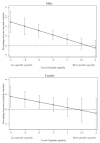Suicidality, Economic Shocks, and Egalitarian Gender Norms
- PMID: 26877572
- PMCID: PMC4750292
- DOI: 10.1093/esr/jcv084
Suicidality, Economic Shocks, and Egalitarian Gender Norms
Abstract
Durkheim conceived of suicide as a product of social integration and regulation. Although the sociology of suicide has focused on the role of disintegration, to our knowledge, the interaction between integration and regulation has yet to be empirically evaluated. In this article we test whether more egalitarian gender norms, an important form of macro-regulation, protects men and women against suicidality during economic shocks. Using cross-national data covering 20 European Union countries from the years 1991 to 2011, including the recent economic crises in Europe, we first assessed the relation between unemployment and suicide. Then we evaluated potential effect modification using three measures of gender equality, the gender ratio in labour force participation, the gender pay gap, and women's representation in parliament using multiple measures. We found no evidence of a significant, direct link between greater gender equality and suicide rates in either men or women. However, a greater degree of gender equality helped protect against suicidality associated with economic shocks. At relatively high levels of gender equality in Europe, such as those seen in Sweden and Austria, the relationship between rising unemployment rates and suicide in men disappeared altogether. Our findings suggest that more egalitarian forms of gender regulation may help buffer the suicidal consequences of economic shocks, especially in men.
Figures




Similar articles
-
Gender Norms and Gender Equality in Full-Time Employment and Health: A 97-Country Analysis of the World Values Survey.Front Psychol. 2022 May 31;13:689815. doi: 10.3389/fpsyg.2022.689815. eCollection 2022. Front Psychol. 2022. PMID: 35769749 Free PMC article.
-
Women's and Men's Status: Revisiting the Relationship Between Gender Equality and Intimate Partner Violence Against Women in Europe.J Interpers Violence. 2023 Aug;38(15-16):8755-8784. doi: 10.1177/08862605231158760. Epub 2023 Mar 13. J Interpers Violence. 2023. PMID: 36915262
-
Impact of social protection on gender equality in low- and middle-income countries: A systematic review of reviews.Campbell Syst Rev. 2022 May 25;18(2):e1240. doi: 10.1002/cl2.1240. eCollection 2022 Jun. Campbell Syst Rev. 2022. PMID: 36913187 Free PMC article. Review.
-
Female labour force participation and suicide rates in the world.Soc Sci Med. 2017 Dec;195:61-67. doi: 10.1016/j.socscimed.2017.11.014. Epub 2017 Nov 10. Soc Sci Med. 2017. PMID: 29154181
-
Gender equality in the 21st century: Overcoming barriers to women's leadership in global health.J Dent Educ. 2022 Sep;86(9):1144-1173. doi: 10.1002/jdd.13059. J Dent Educ. 2022. PMID: 36165260 Review.
Cited by
-
Female political representation and the gender health gap: a cross-national analysis of 49 European countries.Eur J Public Health. 2022 Oct 3;32(5):684-689. doi: 10.1093/eurpub/ckac122. Eur J Public Health. 2022. PMID: 36087336 Free PMC article.
-
Perceived job insecurity and risk of suicide and suicide attempts: a study of men and women in the Swedish working population.Scand J Work Environ Health. 2022 May 1;48(4):293-301. doi: 10.5271/sjweh.4015. Epub 2022 Feb 20. Scand J Work Environ Health. 2022. PMID: 35184203 Free PMC article.
-
Caregiving as suicide-prevention: an ecological 20-country study of the association between men's family carework, unemployment, and suicide.Soc Psychiatry Psychiatr Epidemiol. 2021 Dec;56(12):2185-2198. doi: 10.1007/s00127-021-02095-9. Epub 2021 May 5. Soc Psychiatry Psychiatr Epidemiol. 2021. PMID: 33948679
-
Does gender inequity increase men's mortality risk in the United States? A multilevel analysis of data from the National Longitudinal Mortality Study.SSM Popul Health. 2017 Mar 24;3:358-365. doi: 10.1016/j.ssmph.2017.03.003. eCollection 2017 Dec. SSM Popul Health. 2017. PMID: 29349229 Free PMC article.
-
The transformation of masculinity orientations and work-related attitudes in men treated for depression (TRANSMODE): study protocol for a mixed-methods observational study.BMC Psychiatry. 2023 Jul 10;23(1):492. doi: 10.1186/s12888-023-04979-3. BMC Psychiatry. 2023. PMID: 37430236 Free PMC article.
References
-
- Abrutyn S, Mueller AS. The socioemotional foundations of suicide: a microsociological view of Durkheim’s Suicide. Sociological Theory. 2014;32:327–351.
-
- Adinkrah M. Better dead than dishonored: masculinity and male suicidal behavior in contemporary ghana. Social Science and Medicine. 2012;74:474–481. - PubMed
-
- Bearman PS. The social structure of suicide. Sociological Forum. 1991;6:501–524.
-
- Bonfils L, Humbert AL, Ivaškaitẹ-Tamošiūnė V, Manca AR, Nobrega L, Reingardẹ J, Lestón IR. Gender Equality Index Report. European Institute for Gender Equality; Vilnius, Lithuania: 2013.
Grants and funding
LinkOut - more resources
Full Text Sources
Other Literature Sources
Miscellaneous
